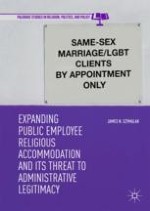2019 | OriginalPaper | Chapter
3. What Even Constitutes Religion?
Author : James N. Szymalak
Published in: Expanding Public Employee Religious Accommodation and Its Threat to Administrative Legitimacy
Publisher: Springer International Publishing
Activate our intelligent search to find suitable subject content or patents.
Select sections of text to find matching patents with Artificial Intelligence. powered by
Select sections of text to find additional relevant content using AI-assisted search. powered by
